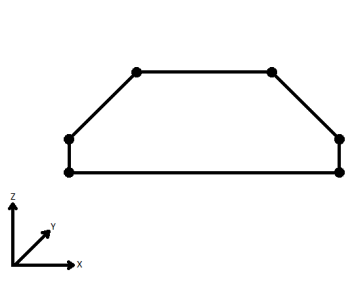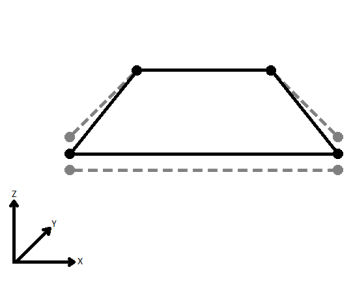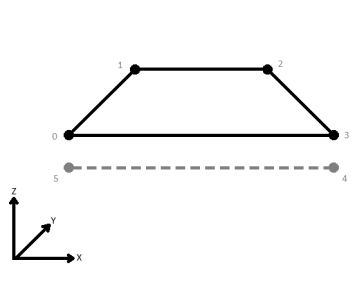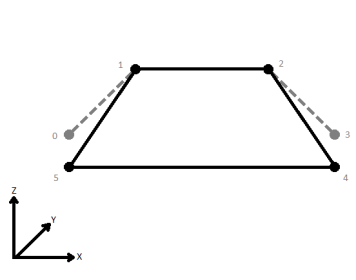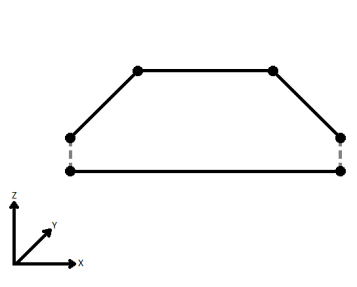FME Transformers: 2024.1
Cuts holes in area features where they fully enclose another area, creating donut polygons.
Typical Uses
- Creating donut polygons
How does it work?
The DonutBuilder receives features with area geometry and constructs donut polygons by cutting holes wherever areas are contained in larger areas.
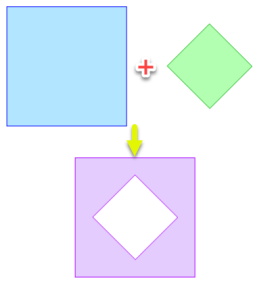
Attributes may be merged or dropped, or accumulated in a list attribute. An optional attribute may be added that indicates whether the output feature is a hole or an outer shell.
Holes may be kept or discarded.
Aggregate input features are deaggregated before processing.
Z coordinates are supported.
Input geometry and spatial relationships
Input areas must be valid and topologically clean, and must have a Contains or Within spatial relationship to successfully produce donuts. Areas that overlap or share boundaries can produce undesirable results.
Input features are not tested for appropriate spatial relationships. The SpatialRelator or SpatialFilter may be useful for filtering features prior to using the DonutBuilder.
Invalid areas will be rejected.
Nested Donuts
Donuts can be nested, such as an island in a lake on an island in a lake. The DonutBuilder will create as many donuts as there are valid donut areas.
When donuts are nested, the Hole Flag attribute will alternate with each level of nesting. The outermost area is an outer shell (Hole Flag = no), the next in is a hole (Hole Flag = yes), the next in is an outer shell, the next a hole, and so on.
When Drop Holes is Yes, areas flagged as holes are discarded, which may be undesirable when they are nested.
Examples
In this example, we have two types of features - a city boundary, and a some historic areas within it. We want to cut the historic areas out of the city polygon.
The city boundary is a polygon with no holes.
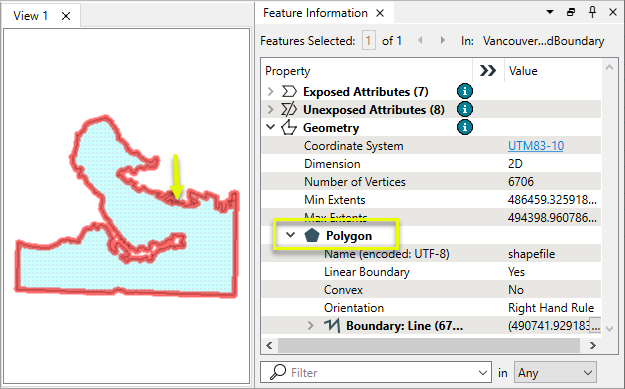
The historic areas are also polygons, and are fully contained within the city boundary. They do not overlap or touch the outer boundary anywhere.
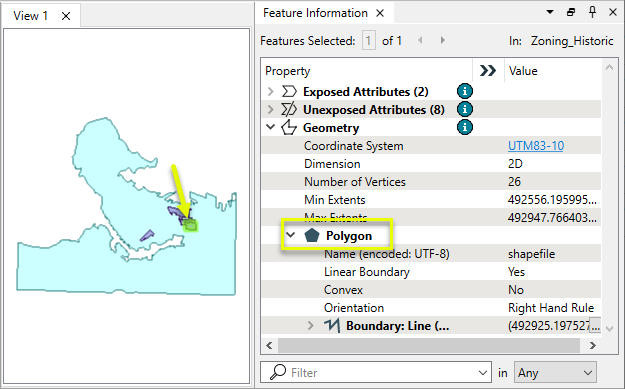
Both feature types are routed into a DonutBuilder.

In the parameters dialog, Drop Holes is set to Yes.
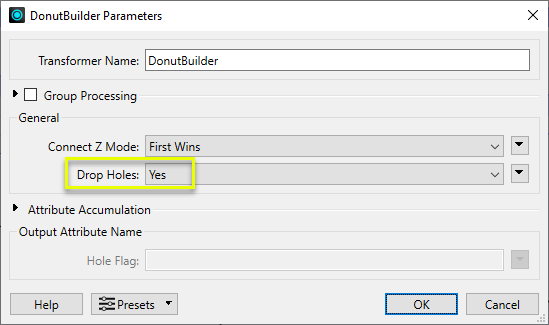
One feature is output, a donut polygon.
Note that there are fewer inner boundaries than input historic areas - some were adjacent and produced contiguous holes.
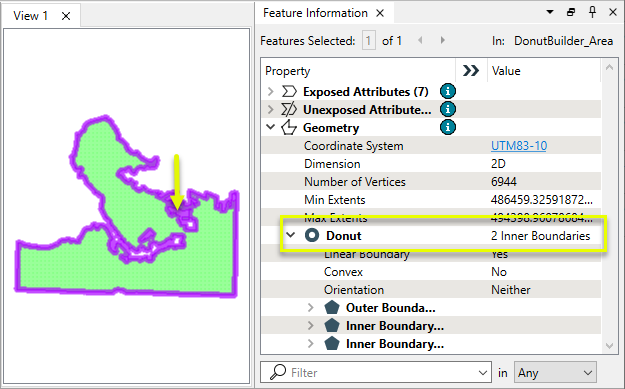
The holes were cut out of the outer area, and then discarded.
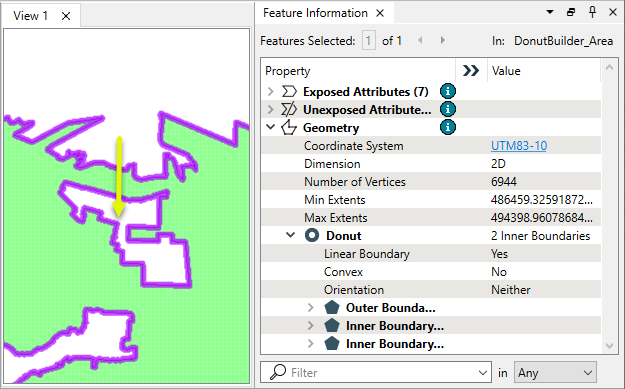
In this example, we have two feature types - lakes and islands. Note that small lakes appear to be present inside the largest lake.
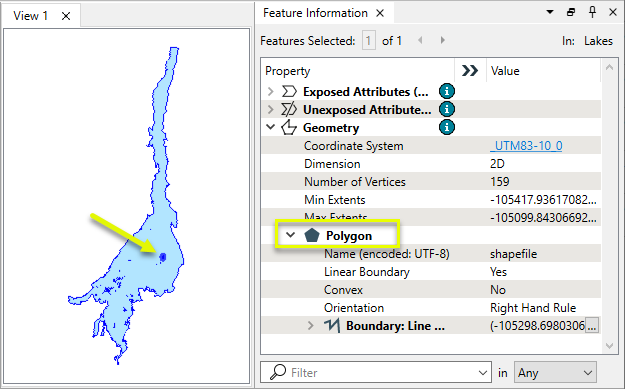
There are numerous islands in the lake, and some of those also contain lakes.
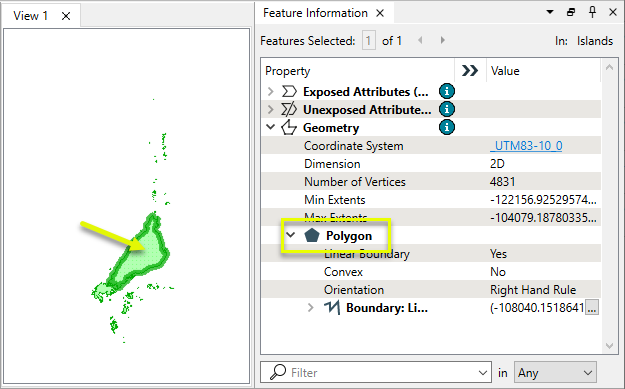
The features are routed into a DonutBuilder. In the parameter dialog, we add a new attribute that will flag which output areas are holes and which are outer shells.
The results will be nested - donuts within donuts - and so we need to keep the holes.
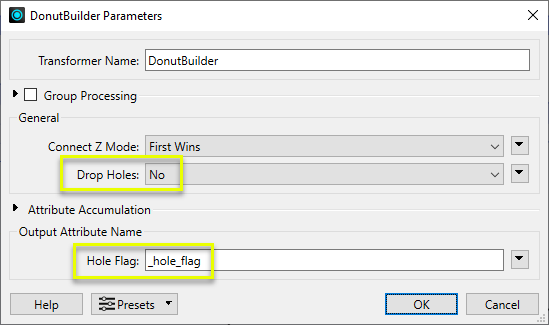
The outermost output donut is the lake. Note that the _hole_flag value is no.
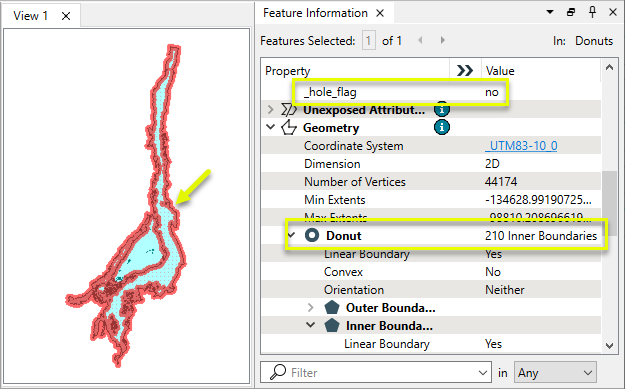
The largest island is a donut within a donut, and is flagged as a hole.
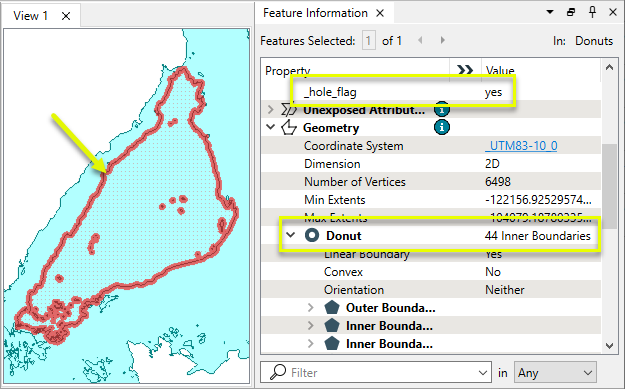
Conditionally color-coding the areas based on the _hole_flag value clearly shows the nesting.
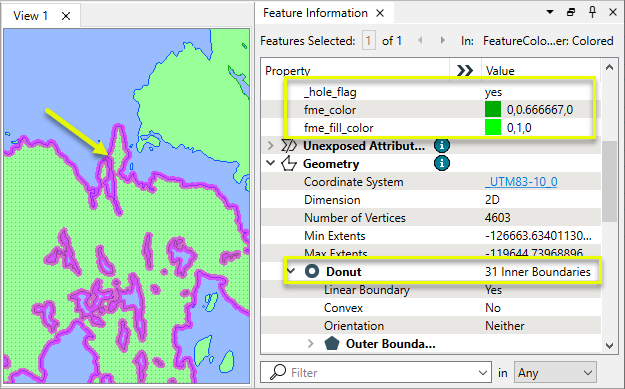
Usage Notes
- The AreaOnAreaOverlayer will also cut holes in areas, creating donuts where they contain another area and modifying the boundary if areas overlap. It does not flag or discard holes, but may be the appropriate choice in some scenarios.
- The GeometryValidator may be useful to identify invalid geometry prior to processing.
Creating and Modifying Area Features
These transformers work with polygons in a variety of ways.
|
|
Function |
Transformer Description |
|---|---|---|
|
Creating areas from topologically connected lines where they form closed shapes. |
Creates polygons from topologically correct linear features. |
|
|
Creating areas from individual linear features. |
Converts a linear feature to an area by connecting the end point to the start point. |
|
|
Combining touching or overlapping areas to create larger areas. |
Combines overlapping and/or adjacent areas into larger contiguous areas by removing shared and interior edges. |
|
|
Calculating areas. |
Calculates the planar or sloped area of polygon geometries and adds the results as attributes. |
|
|
Cleaning up overlaps and gaps to create contiguous coverage. |
Repairs area topologies by resolving gaps and overlaps between adjacent areas. |
|
|
Generalizing areas. |
Generalizes area geometry by connecting and combining neighboring features and/or filling in holes and details. |
|
|
Converting donut areas to non-donut areas by connecting holes to the perimeter. |
Builds connections between donut holes with the outer boundary of a donut, resulting in a polygon-equivalent representation of the input donut. |
|
|
Converting areas within areas to donut holes. |
Cuts holes in area features where they fully enclose another area, creating donut polygons. |
|
|
Separating donut areas into their parts. |
Separates donut polygons into outer shell and hole polygons. |
|
|
Counting the number of holes in a donut area. |
Adds a new attribute whose value is the number of holes in the feature. If the feature is not a polygonal feature, 0 will be returned. |
|
|
Finding polygon overlaps and extracting them into new geometry. |
Performs an area-on-area overlay (intersection of polygons) so that all input areas are intersected against each other and resultant area features are created and output. The resultant areas can accumulate attribute from any overlapping polygons. |
|
|
Finding intersections between lines and polygons, splitting either where they intersect. |
Performs a line-on-area overlay, either splitting lines where they intersect area boundaries or subdividing areas where split by lines. Attributes may be shared between related lines and areas (spatial join). |
|
|
Identifying points that fall within polygons, and sharing attributes between them. |
Performs a point-in-polygon overlay. Points may receive containing area attributes, and areas may receive contained point attributes (spatial join). |
Configuration
Input Ports
Features with area geometry, including donuts. Areas should not overlap or touch.
Output Ports
Donut polygons and holes as specified in parameters. Untouched areas are also output here.
Features with geometry other than valid area geometry are output here.
Rejected features will have an fme_rejection_code attribute with one of the following values:
INVALID_GEOMETRY_TYPE
INVALID_GEOMETRY_VERTICES
INVALID_GEOMETRY_DEGENERATE
Rejected Feature Handling: can be set to either terminate the translation or continue running when it encounters a rejected feature. This setting is available both as a default FME option and as a workspace parameter.
Parameters
|
Group By |
The default behavior is to use the entire set of input features as the group. This option allows you to select attributes that define which groups to form. Each set of features which have the same value for all of these attributes will be processed as an independent group. |
||||
|
Complete Groups |
Select the point in processing at which groups are processed:
There are two typical reasons for using When Group Changes (Advanced) . The first is incoming data that is intended to be processed in groups (and is already so ordered). In this case, the structure dictates Group By usage - not performance considerations. The second possible reason is potential performance gains. Performance gains are most likely when the data is already sorted (or read using a SQL ORDER BY statement) since less work is required of FME. If the data needs ordering, it can be sorted in the workspace (though the added processing overhead may negate any gains). Sorting becomes more difficult according to the number of data streams. Multiple streams of data could be almost impossible to sort into the correct order, since all features matching a Group By value need to arrive before any features (of any feature type or dataset) belonging to the next group. In this case, using Group By with When All Features Received may be the equivalent and simpler approach. Note Multiple feature types and features from multiple datasets will not generally naturally occur in the correct order.
As with many scenarios, testing different approaches in your workspace with your data is the only definitive way to identify performance gains. |
|
Connect Z Mode |
If applicable, select a method for handling z values. When viewed in 2D (ignoring Z), a path (which may define the border of a polygon) may appear to be closed as shown in the left figure below. This same path, when viewed in 3D, may appear to be open as shown in the right figure below.
To specify how (and if) paths should be closed in 3D, select one of the listed modes.
|
||||||||||||||||||
|
Drop Holes |
Select a method for handling areas flagged as holes (not outer shells):
|
Merge Attributes
|
Accumulation Mode |
Select a method for accumulating attributes from holes:
|
||||||
|
Conflict Resolution |
When Accumulation Mode is Merge Hole, select a preference for handling attribute conflicts:
|
||||||
|
Prefix |
When Accumulation Mode is Prefix Hole, this value will prefix attribute names provided by the hole. |
Generate List
When enabled, adds a list attribute to the output donut, retaining attribute values for each input feature that became a hole, in the order that the holes appear on the donut.
|
Hole List Name |
Enter a name for the list attribute. Note List attributes are not accessible from the output schema in FME Workbench unless they are first processed using a transformer that operates on them, such as ListExploder or ListConcatenator. Alternatively, AttributeExposer can be used.
|
|
Add To Hole List |
All Attributes: All attributes will be added to the output features. Selected Attributes: Enables the Selected Attributes parameter, where specific attributes may be chosen for inclusion. |
|
Selected Attributes |
Enabled when Add To Hole List is set to Selected Attributes. Specify the attributes you wish to be included. |
|
Hole Flag |
When Drop Holes is No, name the attribute to contain the hole flag indicator, either yes or no. |
Editing Transformer Parameters
Transformer parameters can be set by directly entering values, using expressions, or referencing other elements in the workspace such as attribute values or user parameters. Various editors and context menus are available to assist. To see what is available, click  beside the applicable parameter.
beside the applicable parameter.
Defining Values
There are several ways to define a value for use in a Transformer. The simplest is to simply type in a value or string, which can include functions of various types such as attribute references, math and string functions, and workspace parameters.
Using the Text Editor
The Text Editor provides a convenient way to construct text strings (including regular expressions) from various data sources, such as attributes, parameters, and constants, where the result is used directly inside a parameter.
Using the Arithmetic Editor
The Arithmetic Editor provides a convenient way to construct math expressions from various data sources, such as attributes, parameters, and feature functions, where the result is used directly inside a parameter.
Conditional Values
Set values depending on one or more test conditions that either pass or fail.
Parameter Condition Definition Dialog
Content
Expressions and strings can include a number of functions, characters, parameters, and more.
When setting values - whether entered directly in a parameter or constructed using one of the editors - strings and expressions containing String, Math, Date/Time or FME Feature Functions will have those functions evaluated. Therefore, the names of these functions (in the form @<function_name>) should not be used as literal string values.
| These functions manipulate and format strings. | |
|
Special Characters |
A set of control characters is available in the Text Editor. |
| Math functions are available in both editors. | |
| Date/Time Functions | Date and time functions are available in the Text Editor. |
| These operators are available in the Arithmetic Editor. | |
| These return primarily feature-specific values. | |
| FME and workspace-specific parameters may be used. | |
| Creating and Modifying User Parameters | Create your own editable parameters. |
Table Tools
Transformers with table-style parameters have additional tools for populating and manipulating values.
|
Row Reordering
|
Enabled once you have clicked on a row item. Choices include:
|
|
Cut, Copy, and Paste
|
Enabled once you have clicked on a row item. Choices include:
Cut, copy, and paste may be used within a transformer, or between transformers. |
|
Filter
|
Start typing a string, and the matrix will only display rows matching those characters. Searches all columns. This only affects the display of attributes within the transformer - it does not alter which attributes are output. |
|
Import
|
Import populates the table with a set of new attributes read from a dataset. Specific application varies between transformers. |
|
Reset/Refresh
|
Generally resets the table to its initial state, and may provide additional options to remove invalid entries. Behavior varies between transformers. |
Note: Not all tools are available in all transformers.
For more information, see Transformer Parameter Menu Options.
Reference
|
Processing Behavior |
|
|
Feature Holding |
Yes |
| Dependencies | None |
| Aliases | |
| History |
FME Community
The FME Community is the place for demos, how-tos, articles, FAQs, and more. Get answers to your questions, learn from other users, and suggest, vote, and comment on new features.
Search for all results about the DonutBuilder on the FME Community.
Examples may contain information licensed under the Open Government Licence – Vancouver, Open Government Licence - British Columbia, and/or Open Government Licence – Canada.

